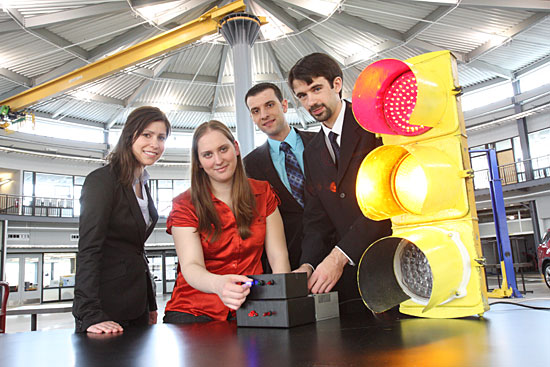

Yet these signals pose a new hazard to drivers during inclement weather: the LED bulbs do not emit as much heat as conventional bulbs, allowing snow or ice to accumulate and obstruct them during certain weather conditions.
But a group of UM-Dearborn engineering students have researched and designed a potential life-saving solution---a resistive heater wire system that can be placed across the lens of LED bulbs.
The team built the heater wire defroster as part of the College of Engineering and Computer Science's annual senior design competition. The group's project was the overall winner of the 2011 competition.
The students worked under the direction of Oleg Zikanov, professor of mechanical engineering at UM-Dearborn.
"It was a great group of students who decided to work on a real life problem," Zikanov said. "They were able to conduct a state-of-the-art experimental and theoretical analysis of possible designs. I think their estimate of what it will take in terms of energy to solve the problem is quite accurate."
The team of engineering students--William Schmelter, Elizabeth Shnerpunas, Murad Swaidan and Heather Velliky-was inspired to work on the project after reading a New York Times story about a 34-year-old woman who was killed when a driver ran a snow-obscured red LED traffic signal.
"Knowing that this issue was real and was a major safety hazard in severe cold weather areas got us motivated immediately," said Shnerpunas on behalf of her group.
The team sought the most effective and economical solution to prevent snow from covering LED traffic lights, and found the heat wire defroster which dissipates heat throughout the lens surface was the most feasible and a solution that could be used with new or existing traffic lights.
To test the effectiveness, precise experiments were performed in climate room environment to simulate extreme climate conditions. The power supply that is sufficient to eliminate any possibility of snow buildup was found to be 49 watts, with the total power usage of the LEDs and heater being much less than what is required for incandescent bulbs.
Several options were considered in order to improve the energy efficiency of the design, including the addition of a photo-sensor and control system to manage the operation of the heater.
The LED traffic signal with the incorporated heater still provides substantial energy savings over incandescent fixtures; it consumes less than half of the power of a standard incandescent traffic signal.
"It was a great experience to work on a project that we were able to see through, from our initial ideas to a working prototype," Shnerpunas said. "It was really beneficial to work in a team environment, in a situation where we had to define our own conditions and just work by building upon what we know. This type of scenario felt the closest to a real engineering project than any type of assignment we received in the past. We've learned a lot about team dynamics, and the importance of setting up a clear plan and approach for the project."
Photo by John Gambotto.




